Gladesville Mental Hospital
The Gladesville Mental Hospital, formerly known as the Tarban Creek Lunatic Asylum, was a psychiatric hospital established in 1838 in the suburb of Gladesville, Sydney, New South Wales in Australia. The hospital officially closed in 1993, with the last in-patient services ceased in 1997.
| Gladesville Mental Hospital | |
|---|---|
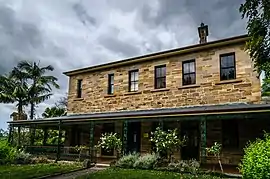 The Medical Superintendent's Residence of the former hospital | |
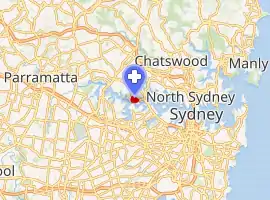
| |
| Geography | |
| Location | Gladesville, New South Wales, Australia |
| Organisation | |
| Type | Disused mental hospital |
| Services | |
| Links | |
| Lists | Hospitals in Australia |
Building details | |
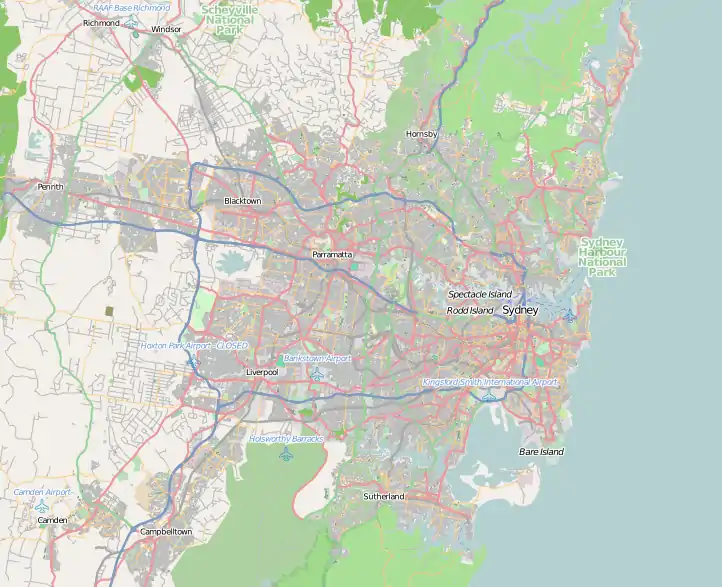 Location in Greater Sydney | |
| Alternative names | Tarban Creek Lunatic Asylum |
| General information | |
| Coordinates | 33°50′16″S 151°07′51″E |
| Construction started | 1836 |
| Completed | 1838 |
| Opened | 19 November 1838 |
| Closed | 29 January 1993 |
| Owner | Government of New South Wales via NSW Ministry of Health |
| Technical details | |
| Material | Sandstone |
| Size | 25.4 Hectarea |
| Design and construction | |
| Architect | |
| Architecture firm | Colonial Architect of New South Wales |
| Other designers |
|
| References | |
| [1][2] | |
| Official name | Gladesville Hospital Precinct |
| Criteria | a., c., d., e. |
| Designated | 1 December 1995 |
| Reference no. | s.170 NSW State agency heritage register |
Description and history
Prior to 1838, people with mental or emotional problems in the Sydney area were housed in a "lunatic asylum" in Gladesville, a suburb located on the Northern banks of the Parramatta River between Sydney and Parramatta, or at the Female Factory in Parramatta, twenty-four kilometres west of Sydney. In the 1830s, construction of a purpose-built asylum began on the banks of the Parramatta River, in the area now known as Gladesville. The original sandstone complex originally known as Tarban Creek Lunatic Asylum was designed by the Colonial Architect, Mortimer Lewis, between 1836 and 1838.[3] Patients were then transferred from Liverpool and the Female Factory. Additional buildings in the hospital grounds precinct were designed by James Barnet.[4][5]
On 29 January 1993 Gladesville Hospital, together with Macquarie Hospital, was revoked as a hospital, and was amalgamated to form the Gladesville Macquarie Hospital. The last in-patient services were closed in 1997.[2]
The first supervisor was John Thomas Digby, who sought to improve the treatment of the mentally ill, as did his successor, Frederick Norton Manning. On a visit to Sydney in 1867, Manning was invited by Henry Parkes to become medical superintendent of the Tarban Creek Lunatic Asylum. Before accepting, Manning went overseas and studied methods of patient care and administration of asylums; on his return to Sydney he submitted a notable report. He was appointed to Tarban Creek on 15 October 1868 and immediately reported on the isolation of patients from their relations in accommodation best described as 'prison-like and gloomy', the inadequate facilities for their gainful employment and recreation and the monotonous diets deficient in both quantity and quality. In January 1869 the asylum's name was changed to the Hospital for the Insane, Gladesville, wherein patients were to receive treatment rather than be confined in a 'cemetery for diseased intellects'. By 1879 radical changes in patient care and accommodation had been made. Gladesville was extended and modernized and an asylum for imbeciles set up in Newcastle and a temporary asylum at Cooma. Manning minimized the use of restraint and provided for patient activities
The hospital continued to grow, sometimes through acquiring nearby properties. One notable acquisition was that of heritage-listed The Priory, a two-storey sandstone house in Salter Street, Gladesville.[6] The house was built in the late 1840s, possibly by a family named Stubbs. In the 1850s, it was sold to the Marist Fathers, who had an influence on the early development of Hunters Hill. The hospital acquired it in 1888. It was listed on the (now defunct) Register of the National Estate in 1978.[7]
In 1915, the designation was changed again when the complex became known as the Gladesville Mental Hospital. In 1993, the Gladesville hospital was amalgamated with the Macquarie Hospital at North Ryde to create Gladesville Macquarie Hospital. In 1997, all inpatient services were consolidated at the Macquarie, North Ryde site.[2]
Heritage listings
The following buildings and structures have various heritage listings on the New South Wales State Heritage Register, the local government register of the New South Wales Heritage Database, and/or the (now defunct) Register of the National Estate.[8]
- Cypress Grove, Victoria Road[9]
- Doctor's Residences, south side of Punt Road gates and around Crown Close commonly called The Circle
- Escarpment Terraces
- Former Medical Superintendent's Residence, designed by Barnet[4]
- Gardener's Store
- Gatekeeper's Cottage, near Punt Road gates
- Gatekeeper's Lodge, Victoria Road
- Medical Records Department, Victoria Road[10]
- Original Quadrangle Complex of 1838
- Pottery Building[11]
- Provision Store[12]
- Punt Road gates[13]
- Sandstone and stone walling within the hospital grounds[14][15]
- Service Buildings group, between 1838 buildings and Punt Road gates
- The Priory, Salter Street[6][16][17]
- Wards 17 and 18, designed by Barnet[5]
- Workshop (former Male Ward 9)[18]
Gallery
 Building 30
Building 30 Wards 17 and 18
Wards 17 and 18 Gate cottage, Punt Road
Gate cottage, Punt Road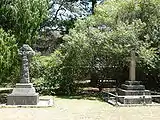 Graves of Dr Eric Sinclair, left, and Frederick Norton Manning, Victoria Road
Graves of Dr Eric Sinclair, left, and Frederick Norton Manning, Victoria Road Gate cottage, Victoria Road
Gate cottage, Victoria Road Building 11
Building 11 Digby House, named after John Thomas Digby
Digby House, named after John Thomas Digby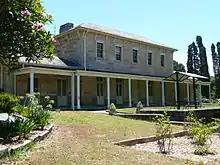 The Priory, Salter Street
The Priory, Salter Street
See also
References
- "Gladesville Hospital Precinct". New South Wales State Heritage Register. Office of Environment and Heritage. Retrieved 22 November 2017.
- "Records agency: Gladesville Hospital". State Records and Archives. Government of New South Wales. Retrieved 26 November 2017.
- The Heritage of Australia, Macmillan Company, 1981, p.2/29
- "NSW Medical Board Offices". New South Wales Heritage Database. Office of Environment and Heritage. Retrieved 22 November 2017.
- "Ward 18 - Acute Admissions". New South Wales Heritage Database. Office of Environment and Heritage. Retrieved 22 November 2017.
- "The Priory". New South Wales State Heritage Register. Office of Environment and Heritage. H01720. Retrieved 2 June 2018.
- "Gladesville Mental Hospital Precinct, Punt Rd, Gladesville, NSW, Australia (Place ID 2620)". Australian Heritage Database. Department of the Environment. Retrieved 16 January 2009.
- The Heritage of Australia, p.2/30
- "Cypress Grove". New South Wales Heritage Database. Office of Environment and Heritage. Retrieved 22 November 2017.
- "Medical Records Department". New South Wales Heritage Database. Office of Environment and Heritage. Retrieved 22 November 2017.
- "Punt Road Gates". New South Wales Heritage Database. Office of Environment and Heritage. Retrieved 22 November 2017.
- "Stores (General and Provision)". New South Wales Heritage Database. Office of Environment and Heritage. Retrieved 22 November 2017.
- "Punt Road Gates". New South Wales Heritage Database. Office of Environment and Heritage. Retrieved 22 November 2017.
- "Sandstone walling". New South Wales Heritage Database. Office of Environment and Heritage. Retrieved 22 November 2017.
- "Stone Wall". New South Wales State Heritage Register. Office of Environment and Heritage. Retrieved 22 November 2017.
- "The Priory". New South Wales Heritage Database. Office of Environment and Heritage. Retrieved 22 November 2017.
- "The Priory". New South Wales Heritage Database. Office of Environment and Heritage. Retrieved 22 November 2017.
- "Workshops". New South Wales Heritage Database. Office of Environment and Heritage. Retrieved 22 November 2017.
Attribution
![]() This article incorporates text by New South Wales State Heritage Register available under the CC BY 3.0 AU licence.
This article incorporates text by New South Wales State Heritage Register available under the CC BY 3.0 AU licence.
External links
| Wikimedia Commons has media related to Gladesville mental hospital. |
- "Search: Heritage Register". New South Wales State Heritage Register. Government of New South Wales.